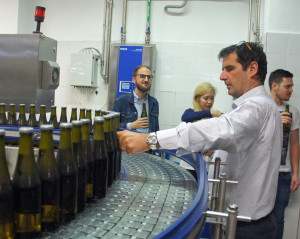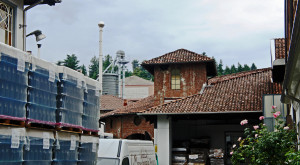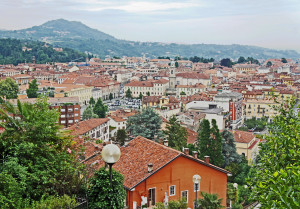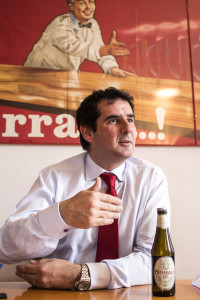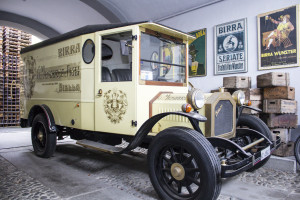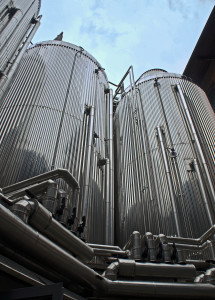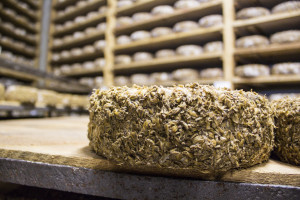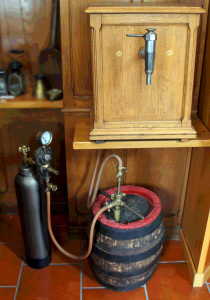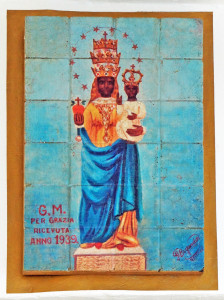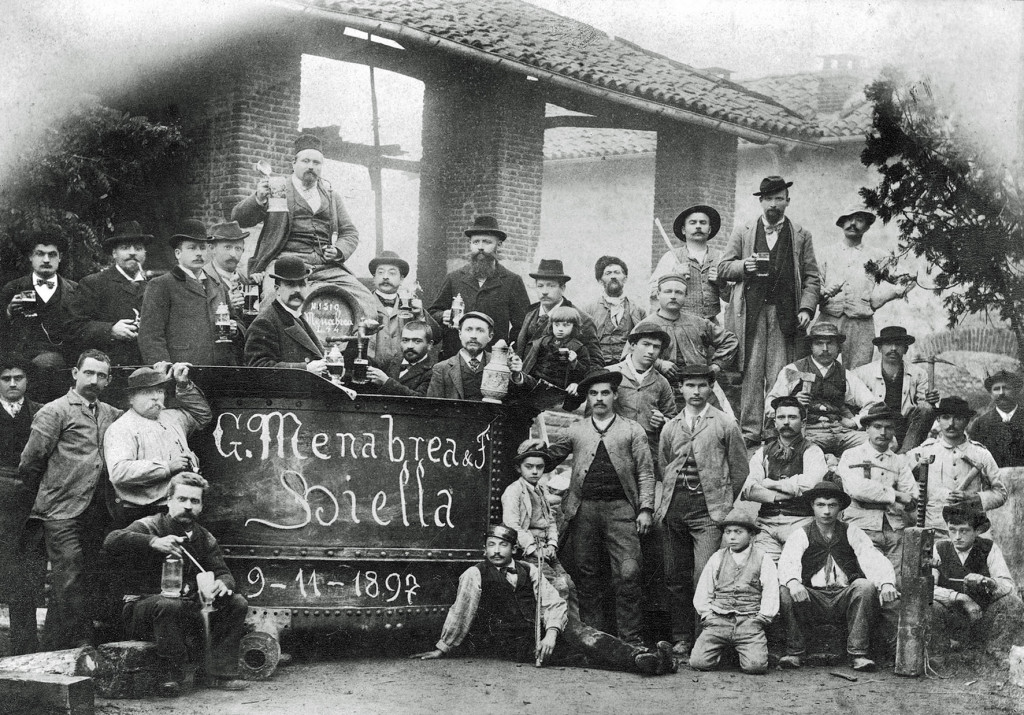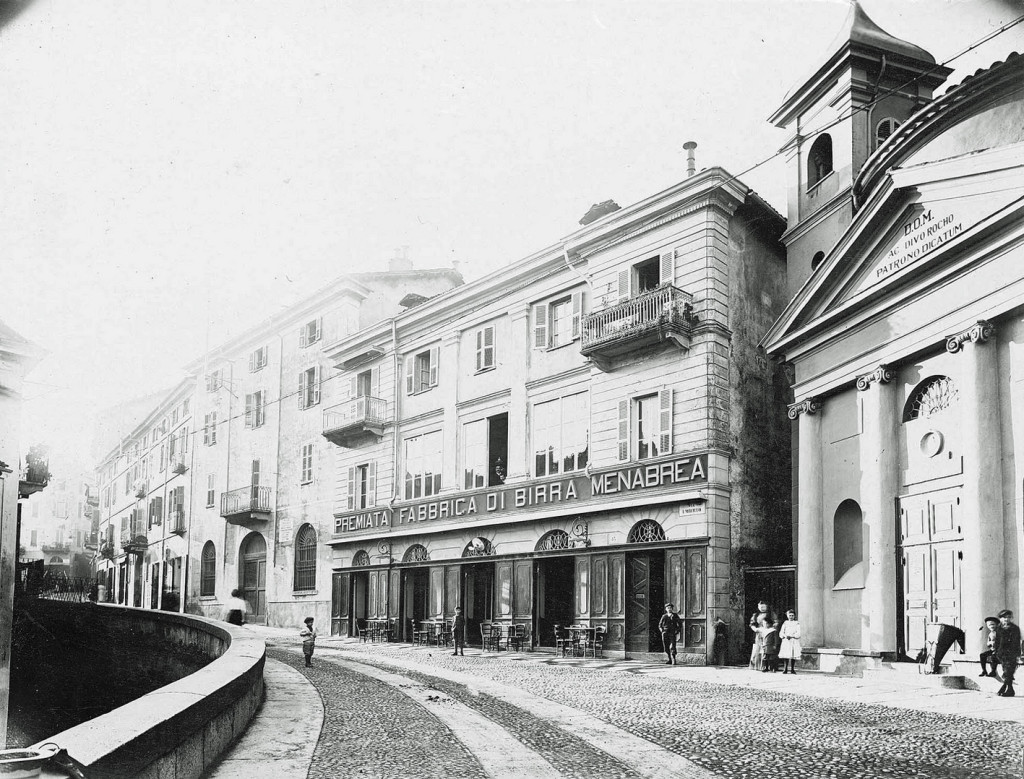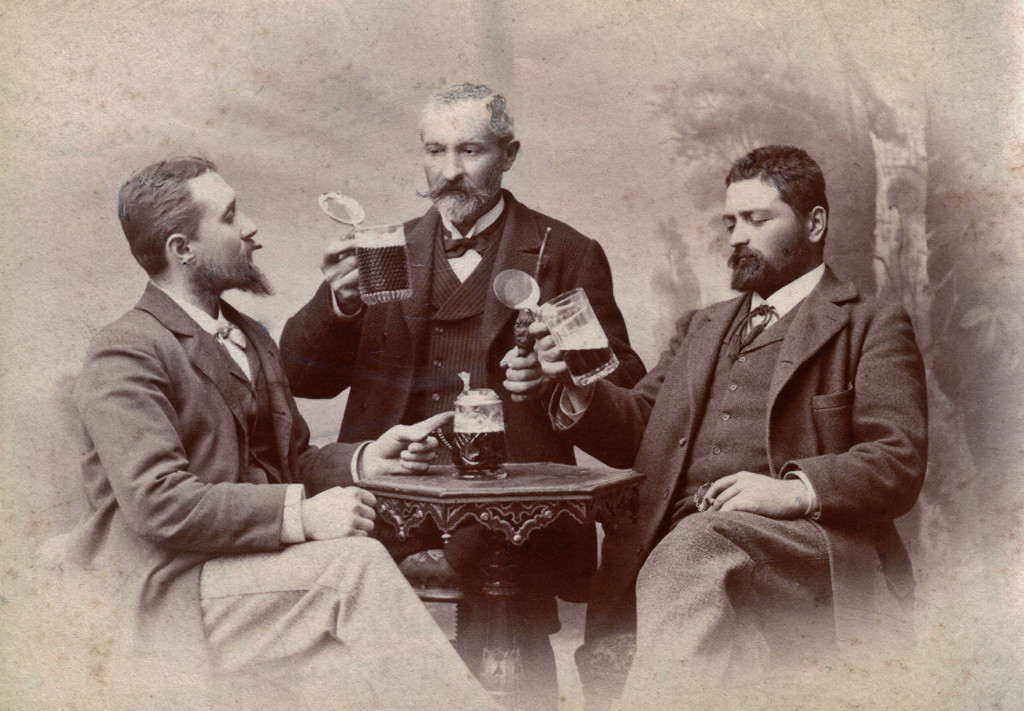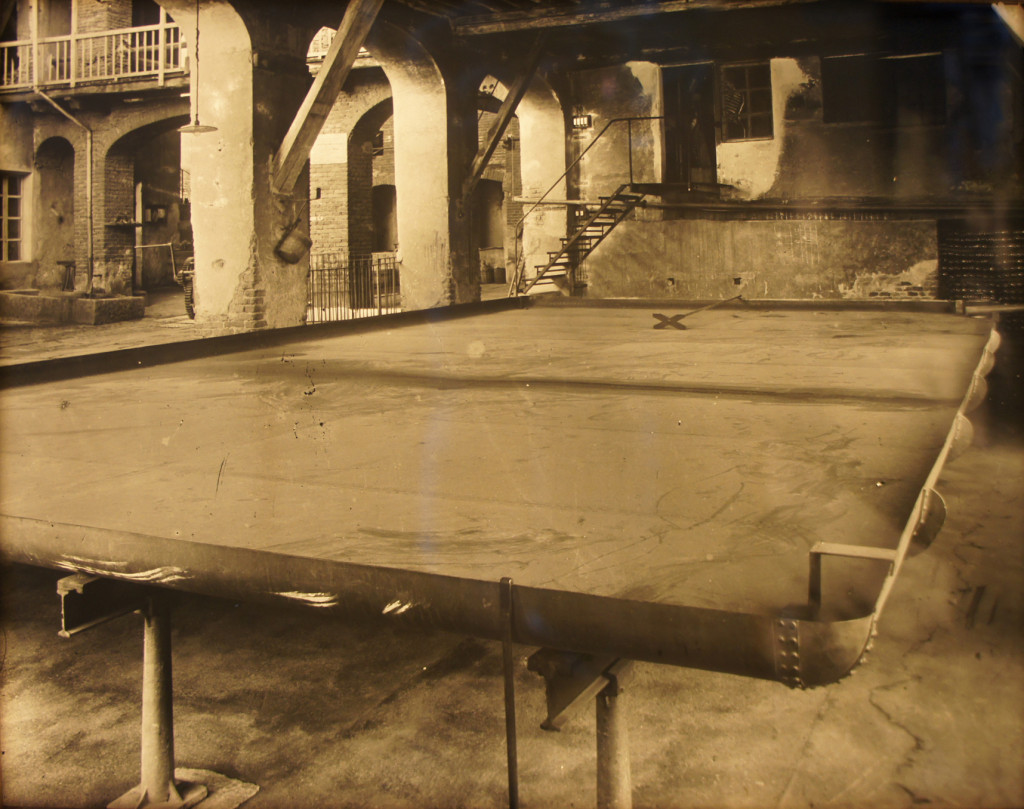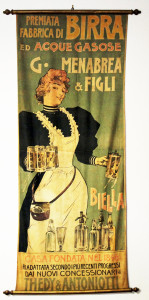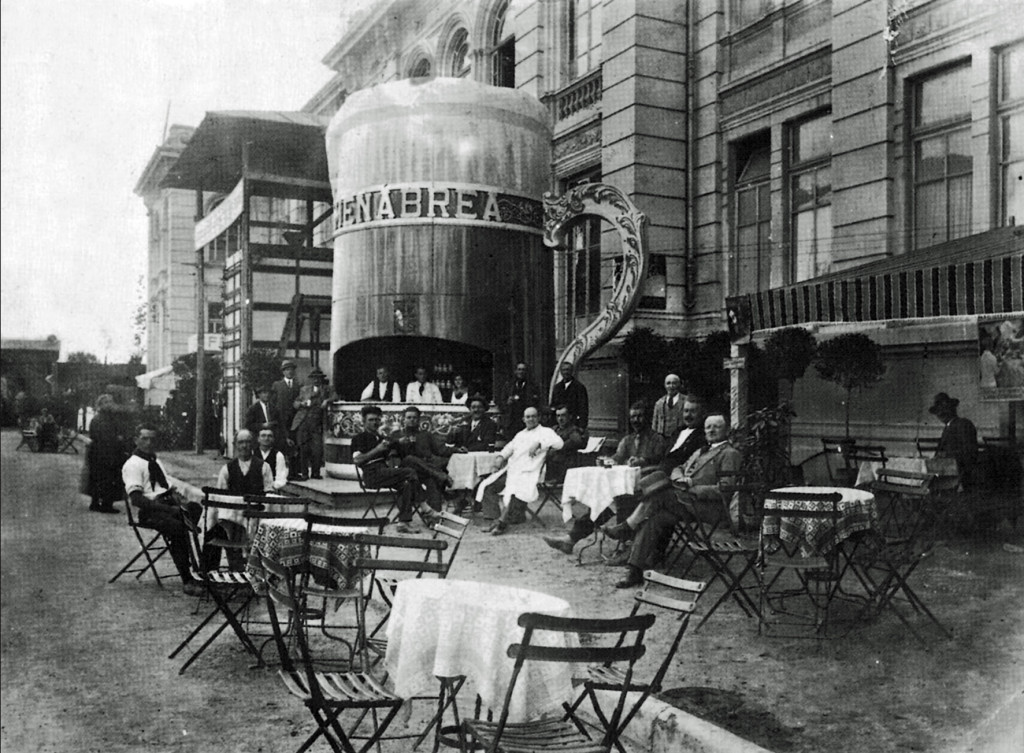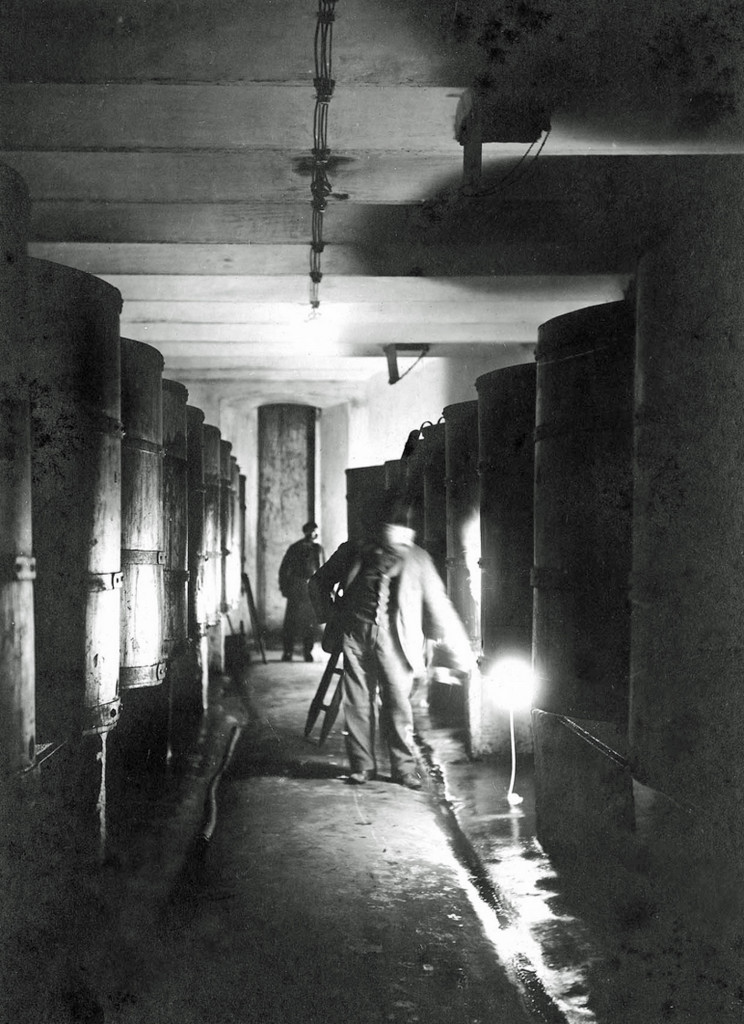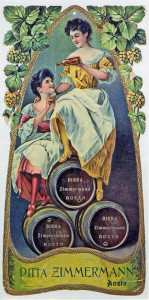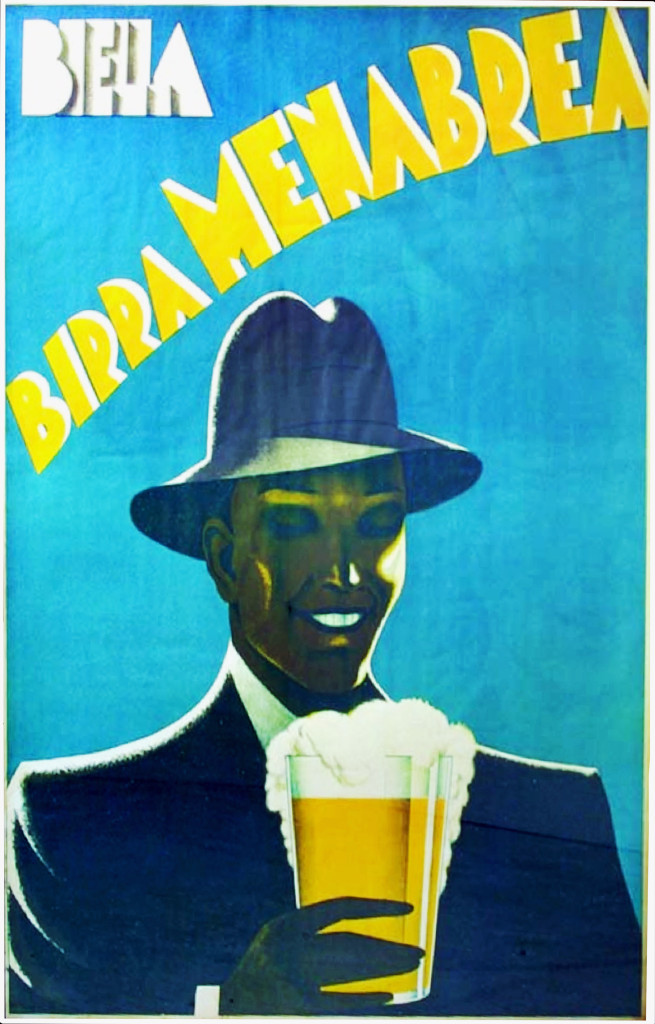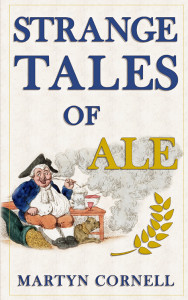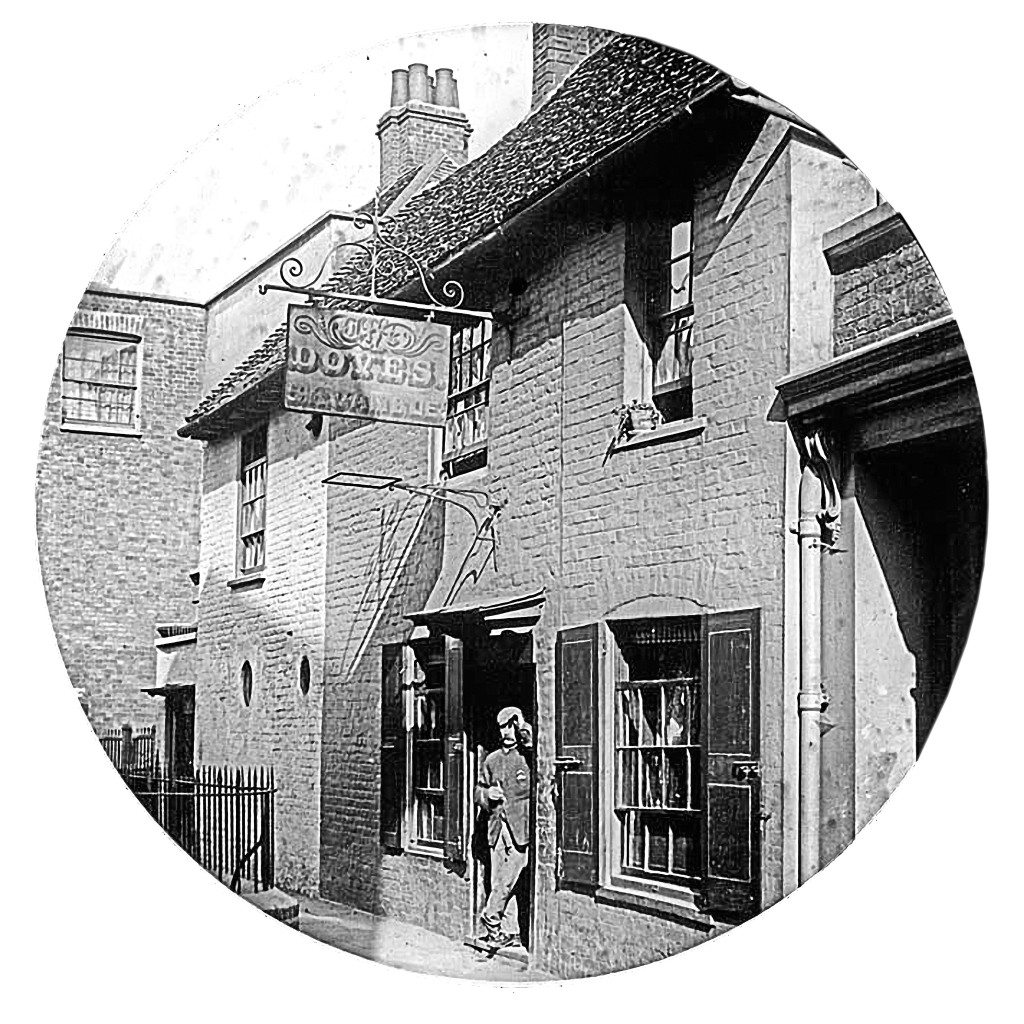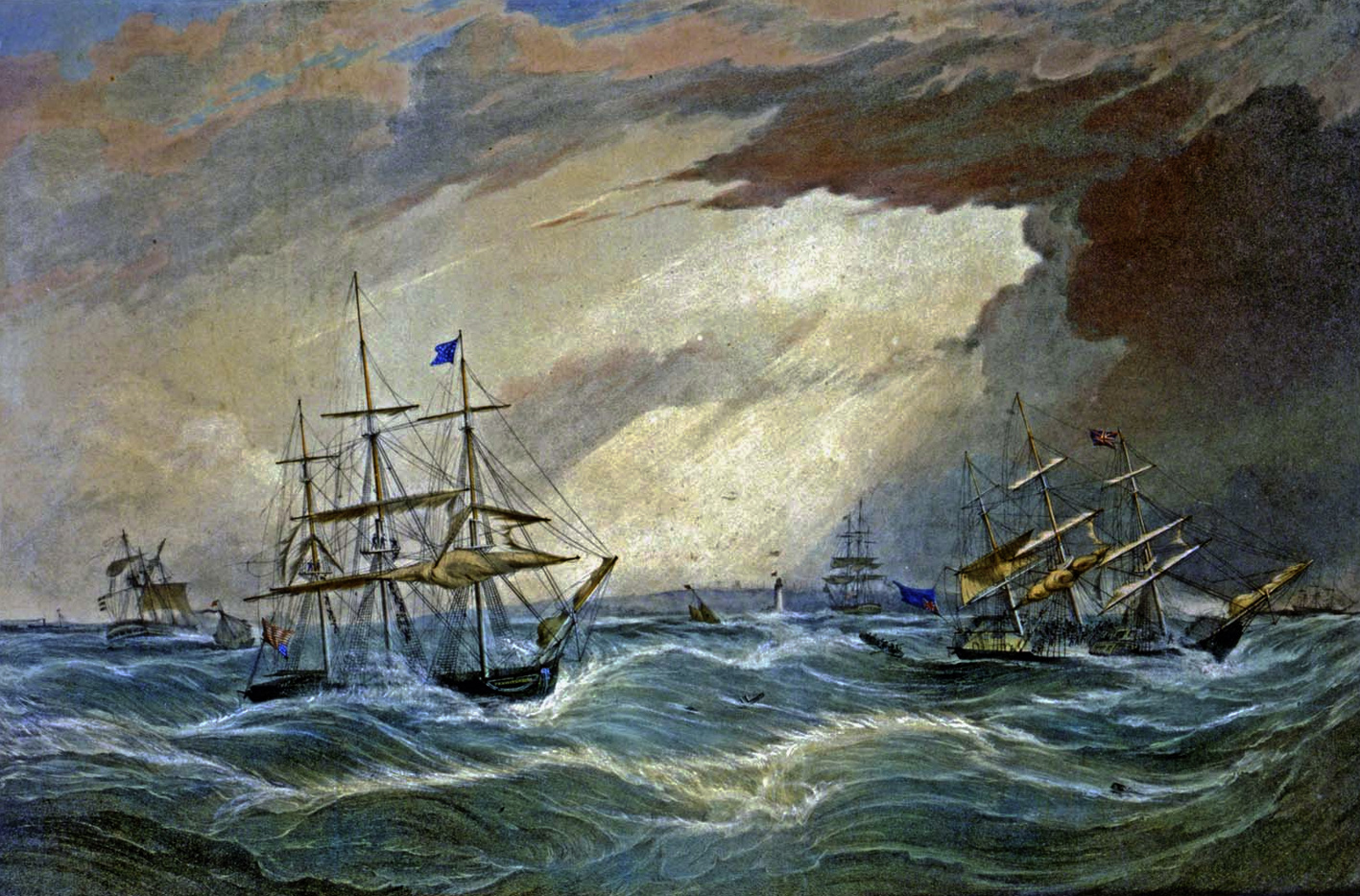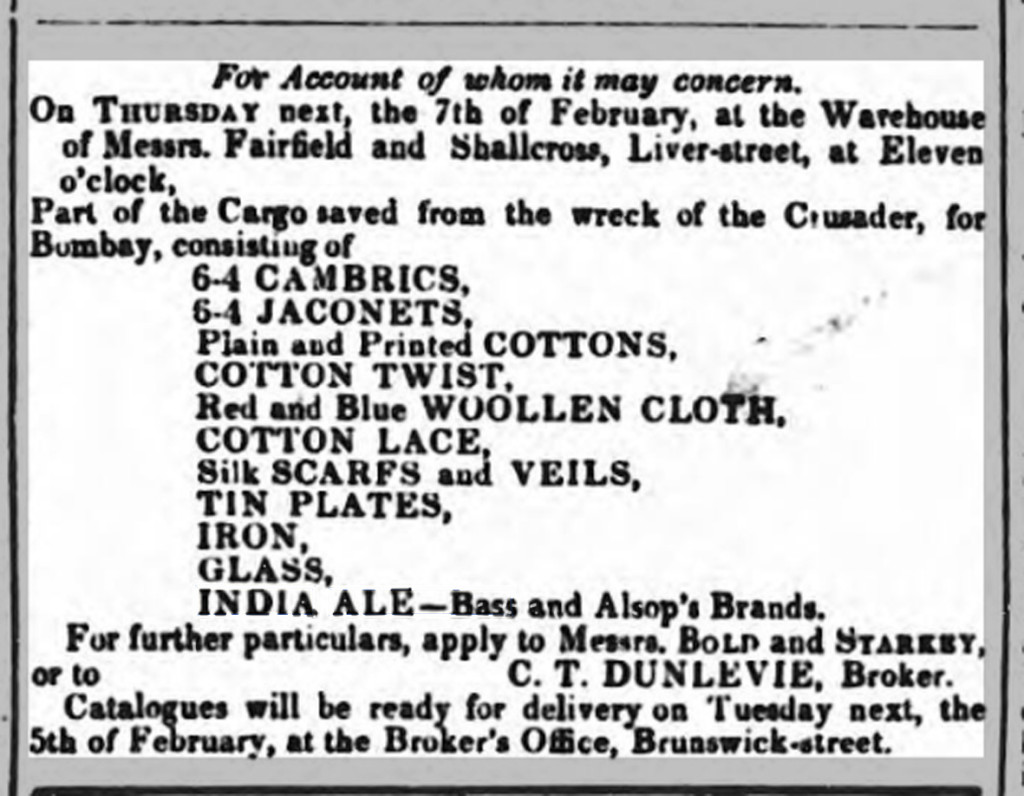Loved and disliked in equal parts, and enjoying an unexpected renaissance in hipstery parts, despite being more than 70 years old, the dimpled beer mug is undoubtedly an icon of England.
It was invented in 1938 at the Ravenhead glassworks in St Helens, Lancashire by an in-house designer whose name is now forgotten, and given the factory identity “P404″. Although the dimple has its enemies, who dislike its weight and its thickness, it soon became extremely popular, and at a rough guess some 500 million have been manufactured since it was born.
Clik here to view.

Strawberry pink pint beer mug of the kind George Orwell enjoyed, stamped ‘Pint MxCC GR 29′, for Middlesex County Council
The dimple had much competition: even in 1938, many pubs still served beer in the pottery mugs that George Orwell praised in his “Moon Under Water” essay about his ideal pub, from the Evening Standard in 1946. Orwell declared that “in my opinion beer tastes better out of china,” but “china mugs went out about 30 years ago [that is, during the First World War], because most people like their drink to be transparent.” However, two documentary films made just before Orwell’s essay, The Story of English Inns, from 1944, and Down at the Local, from 1945, both show pint china mugs were still being used alongside glass ones, at least in country pubs. Orwell talked about the pottery beer mug as being strawberry-pink in colour, but they came in other shades (baby blue and a dark biscuit-beige, for example), all with white interiors and white handles, and also with transfer-print designs, though the majority of pottery beer mugs appear, in fact, to have been of the kind known as mochaware, invented around the end of the 18th century, which have tree or fern-like patterns on the sides, made by a drop of acid dropped onto the glaze of the mug while it was still wet. Most mochaware pint beer mugs seem to have been blue, or beige-and-blue, with black and white bands. Many were made by TG Green of Church Gresley, South Derbyshire, while the plain coloured mugs were the speciality of Pountneys of Bristol. TG Green stopped producing mochaware at the outbreak of war in 1939, when it was apparently the last company still making mochaware beermugs. It tried to revive the tradition in 1981, without success. The company closed in 2007.
Pewter mugs were pretty much obsolete by the middle of the 20th century, though Orwell claimed that “stout … goes better in a pewter pot”, and they were described as “old-fashioned” even in 1900, when it was said to have been replaced by the glass mug, “a thick, almost unbreakable article”. The problem, for publicans, was that their pewter pots kept being stolen, and they cost around ten times as much as china beer mugs. The better class of premises kept silver-plated pewter beermugs and, to guard against theft, carved the name and address of the pub into the base. Glass was also cheaper – and, it was claimed, the working man at the end of the 19th century liked to have his mild beer served in a glass so that he could see it was bright, and not hazy or cloudy.
Clik here to view.

Two men drinking from china pint mugs, one mochaware, the other transfer printed, from the film The Story of English Inns, 1944
Fortunately for the beer mug collector, after the Weights and Measures Act of 1878, drinking vessels used on licensed premises for draught beer or cider purporting to be a specific size – half-pint, pint or quart – had to bear an Official Stamp Number, either acid etched or sand-blasted through a stencil, a system that lasted, with tweaks, until 2007, and each district – county council, county borough and the like – had its own numbers, so that, for example, 19 was Derbyshire and 490 Bristol. They also carried the mark of the crown, and the initials of the reigning monarch of the time, something that had first been required by the Act “for ascertaining the Measures for retailing Ale and Beer” that had become law under William III in 1700. (That Act covered vessels “made of wood, earth, glass, horn, leather, pewter or of some other good and wholesome metal”, suggesting the variety of drinking vessels you could expect in a Stuart inn or alehouse, and it also only mentions quarts and pints, suggesting the half-pint was illegal – or at least extremely rare.) It is thus possible to tell roughly when an older beer mug was made, and roughly where, too. In 2007, when the CE, or “Conformitée Européenne” mark replaced the old system (leading to the Daily Mail to declare: “EU stealing the crown of the great British pint”), it became easier to tell when a glass was made, but no simpler to find our where and by whom. Alongside the CE on the glass will be an “M” and the last two digits of the year of manufacture, plus the identification number of the “notified body” that verified that the container was an accurate measure. To indentify the notified body you have to go to the Nando website – nothing to do with peri-peri chicken, this stands for New Approach Notified and Designated Organisations.
Glasses specifically for drinking beer out of have been made in Britain since at least 1639, when a glasshouse (probably in Newcastle upon Tyne) owned by Sir Robert Mansell, who had acquired a monopoly on glass making, was selling beer glasses at a price half that of similar glasses imported from Venice. But such glasses were still expensive: in the 1660s a glasshouse owned by the Duke of Buckingham in London was selling “English Christall” beer glasses at six pence each, equivalent to more than £50 today. These were bowl-shaped glasses, with broad feet and heavy “knops”, the technical term for the ornamental knobs on the stem. Later, in the 18th century, beer and ale glasses became smaller and more delicate – at least in part because glass was taxed by weight from 1745 onwards – and were frequently decorated with fine engravings of hops, barley and so on. These engraved glasses held just five ounces (14cl) of strong beer or ale, or less. But they were still restricted to the rich: when all the belongings of the late Earl of Grantham were auctioned off in February 1755, for example, among all the “fine pictures, antique marble busts, large wardrobe of linnen, curious and magnificent collection of fine old Japan China, &c” for sale were 53 jelly glasses, 18 water glasses, 18 wine glasses and 30 beer glasses. Those beer glasses cost a hefty two to three shillings each, after tax, and according to a letter in the Pottery and Glass Trades Journal in October 1879, because of the expense of glass, in the pub, inn or tavern, “time was” that ale in a glass tumbler cost more than the same drink in a pewter mug: two pence per half pint, against one and a half pence.
It would take the invention of pressed glass, made by pressing semi-molten glass into an iron mould, before beer glasses could begin to come into the reach of the common drinker. Pressed glass was being made in Europe in the late 18th century, but the first patent for a commercial glass-pressing machine was granted in the United States in 1825 to John Palmer Bakewell, son of an English-born Pittsburgh glassmaker, Benjamin Bakewell. The first glass-pressing machine in Britain was installed at the Wordsley Flint Glass Works in Stourbridge in 1833, founded by Benjamin Richardson, whose firm became the first in the country to make mass-produced pressed glass tumblers. Indeed, before pressed glass, tumblers – handle-less, footless glasses, tapering (known as “conical”) or straight-sided – and glass mugs, with handles (called “cans” by the glass makers), were difficult to produce. Moulded glass made their manufacture much easier.
However, in Britain glass remained relatively expensive until the abolition of the glass tax in 1845, which caused an “immense” increase in the production of glass of all kinds. But even after that date, the evidence suggests that glass drinking vessels remained rare in pubs until the end of the Victorian period. While the catalogue of the Great Exhibition in Hyde Park in 1851 showed Thomas Webb of Platt’s Glass Works, near Stourbridge, exhibiting “ales” among his many types of glassware, from sugar bowls to vases, this appears to be the only specific mention of beer glasses among the more than 30 British glassware manufacturers there, and can be put alongside the porcelain porter mug exhibited by the Hanley pottery manufacturer Charles Meigh & Sons. There were more foreign exhibitors of beer glasses, from Prague and Prussia, than British. Three decades later, John Henry Henshall’s painting In the Pub from 1882, otherwise known as “Behind the Bar”, a view of what is believed to be a pub in Old Street or Caledonian Road, London from the staff side of the operation, appears to show only pewter pots on the shelves and in the sinks.
Clik here to view.

In John Henry Henshall’s 1882 London pub there are no glass beer mugs, only pewter pots
A decade later, however, there was suddenly a rush of evidence for the increasing popularity of beer in glass containers. In June 1894 the Portsmouth Evening News reported:
It has been noticed, says the Daily News, that the old-fashioned pewter pot has disappeared from public-houses and is replaced by beer glasses. In connection with the supply of these glasses – an enormous number of which is required – a serious complaint is heard from the glass trade in London. The stamping and verifying of the glasses costs a penny each – almost as much as the cost of production. Several County Councils in the north of England have been in the habit of allowing the makers to have the glasses stamped, under supervision of Council officials, on their own premises. This means a saving to the Councils, and they allow the manufacturers rebates of 30 or 40 per cent, which enables them to compete successfully with London makers. The fine machinery which the London County Council obtained to stamp the glasses is therefore now practically standing idle. A few months ago many thousands of glasses were being stamped every week, but now cheap stamped glasses are being imported from the north, the London glass trade is suffering in consequence and the Council is losing its fees. The Board of Trade has decided that it has no power to compel County Councils to stop the rebate system and do their own stamping.
The social researcher Charles Booth, in 1896, wrote in Life and Labour of the People in London that “until comparatively recent years the publican’s customers were very particular as to their ale being served in a ‘nice bright pewter pot’ … the pot is, however, being now largely supplanted by the glass.” Two years later, in 1898, a witness to a parliamentary inquiry into the materials being used to brew beer talked about “the alleged preference of the working man to have his beer in glasses” – which he denied, saying that it was the publicans leading the movement towards glass, because it was cheaper than pewter, and took up less space. All the same, the Brewers’ Journal that year carried an article on brewing “brilliant” beer, saying that there was a “steadily increasing demand for light fresh beers … capable of withstanding the critical glass test”, suggesting that the use of glass mugs and tumblers in pubs was indeed rising because of customer preference.
Although under the 1872 Weights and Measures Act all draught beer or cider sold in quantities of a half pint or more had to be delivered to the customer in glasses bearing an official stamp, there was no such requirement governing the sale of quantities less than half a pint (10 fluid ounces). Publicans asked for “a half pint” or “a pint” or “a quart” had to give their customer exactly that, in a stamped glass, but if asked for “a glass” of beer, as long as it was less than half a pint, it could be any quantity. Most landlords, it would appear, kept a stock of unstamped 8fl oz beer glasses to supply those customers who asked for “a glass” of ale or beer. The charge was a penny: but when David Lloyd George’s budget of 1910 imposed big extra costs on brewers, pushing up the price of beer, a penny for eight fluid ounces was suddenly uneconomical. To keep the retail price of a “glass of beer” at a penny, smaller glasses were needed. A “pony”, holding around a quarter of a pint, 5fl oz, was too small, so the publicans introduced a new beer glass holding four-thirteenths of a pint – 6.15fl oz – which was swiftly dubbed by customers the “Lloyd George”. (The “glass” of beer was finally outlawed by the Weights and Measures Act of 1963, since when draught beer can only legally be sold in stamped glasses holding a third of a pint, half a pint or a pint – and, more recently, two thirds of a pint.)
Clik here to view.

An advertisement for beer tumblers from 1922
Earlier Victorian beer glasses included rummers, or footed goblets, an attractive style that unfortunately died out. Glass beer mugs in late Victorian and Edwardian times seem to have been heavily ribbed, or cylindrical, while the tumblers were slightly slope-sided or conical. An advertisement for British-made beer tumblers from 1932 shows three different types, plain, with a rayed pattern on the bottom, and with internal ribs, in a style called “Venetian”. By 1930 the Crystal Glass Company, a subsidiary of Bagley & Co of Knottingley, West Yorkshire was showing just one type of beer tumbler in its catalogue, the plain conical style, but three different types of glass beer mug: plain and cylindrical; with ribs or dentition around the base; and what was to become the first iconic beer glass, the ten-sided mug.
Clik here to view.

Mr XXX leads his army of ten-sided beer mugs
Who invented the ten-sided mug, where, and exactly when – presumably in the 1920s – is not known: Jobling & Co of Sunderland apparently also had ten-sided mugs in its catalogue, George Davidson of Gateshead may have made them – somebody in Gateshead evidently did – and Ravenhead certainly did too. But they quickly became common, and when the Brewers’ Society began its “Beer is Best” advertising campaign in 1933, to try to reverse falling beer sales, it soon started using the ten-sided mug in its advertising, with the campaign’s mascot, “Mr XXX”, depicted as a cheery face inside a ten-sided pint glass, with arms and legs. While most examples were made in standard clear glass, Bagley & Co made some in yellow glass, and examples in amber glass are also known. Despite, as we shall see, being challenged and eventually being defeated by two rival designs of beer glass, the ten-sided mug was still being made, by Ravenhead in St Helens, as late as 1964, meaning it was in production for at least 35 years, and probably longer.
The first challenger to the ten-sided beer glass was the dimple mug. The design of the dimple, which seems particularly suited to reflecting and refracting the colour of amber beers, such as classic British ales, may have been inspired by the glass beer mugs with a flat hexagonal faceted exterior manufactured in Newcastle upon Tyne in the 1920s and/or early 1930s. The dimple, despite being a Ravenhead design, was also picked up by other manufacturers, notably Dema of Chesterfield, in Derbyshire, which was Britain’s largest domestic glassware manufacturer, though much less well-known to the public that Ravenhead. But the dimple had its enemies, and in 1990 it was the subject of a vicious attack by Design magazine:
What’s short, fat, ugly and increasingly shunned by beer drinkers? The ‘dimple’ beer glass. You know the one; it’s barrel-shaped with indentations, a handle and eco-unfriendly walls of thick glass. An early attempt at ergonomic design, the dimple is a miserable failure. No one’s fingers actually seem to fit the depressions in the glass. The addition of a handle tacitly acknowledges this. Real ale and lager drinkers both dislike the dimple for the same reason; they don’t think the glass shows off the drink to its best advantage. What they want is something taller, slimmer, and less weighty; a thin glass through which they can admire the colour and clarity of the beer. Bar staff aren’t too keen on the dimple, either. It is heavy, awkward to store and does not stack and, because of its bulk and the projecting handle, difficult to wash, especially in the small sinks found in most bars.
Over the next decade, the dimple mug did seem to be disappearing from pubs, as did the traditional question barstaff asked someone asking for a pint: “Straight or handle?”. When the only two makers of the dimple left in Britain, Ravenhead and Dema, went into receivership within months of each other in 2000 and 2001, the headlines insisted: “Dimpled Pint Pots Doomed”. Fortunately for traditionalists, that hasn’t happened, and in the past few years the dimple beer mug has actually become trendy in pubs and bars frequented by bearded hipsters. Even the “straight or handle?” question has returned, at least in some bars. Today, however, your dimpled pint glass is most likely to have been made in China, by someone like the Zibo Hondao Trading Co Ltd of Shandong, or Bengbu Longyu Glass Products of neighbouring Anhui, or the Shanghai Jingsheng Glass Co Ltd, minimum order 100,000 glasses, cost FOB as low as 20p a glass, depending on order size.
Clik here to view.

Two pints of mild and bitter, served in ten-sided glasses in a North of England pub in 194, from the film Down at the Local
The third “Great British beer glass” – though personally it’s one I hate as much as others dislike the dimple – was invented by a largely unsung giant of 20th century British design: Alexander Hardie Williamson. You may never have heard of him, but it is very likely you have drunk out of one or more of the glasses he designed, on thousands of occasions. Hardie Williamson, who was born in 1907, had designed for Bagley & Co in the 1930s, began designing glassware for United Glass, parent company of Ravenhead in 1944, and within a few years produced a host of simple design classics that are, in many cases, still with us today: the champagne saucer, picked up and personalised by Showerings as the Babycham glass, first made in 1948; the Paris wine goblet, designed in 1952; the “New Worthington” stemmed goblet, the Harp lager tankard and more. In all he designed 1,634 glasses for Ravenhead. But his most widely produced design, still to be found in pubs almost everywhere, was the iconic Nonik tumbler, a slightly conical beaker with a bulge around an inch below the rim, first made by Ravenhead in 1948 and given the product number P708. The bulge near the top was intended to keep the rims from being chipped or nicked by rubbing or banging together in the glass washer or on the shelf – hence the name, from “No Nick” – and had the added advantage that the bulge made it easier for the drinker to hold on to their pints when the glass was slippery than with straight-sided tumblers. Unfortunately, it’s irredeemably ugly, with what Design magazine called its “unsightly bulge”.
That has not, however, prevented it from becoming probably Britain’s most ubiquitous glass. Like the dimple, the Nonik was quickly copied by other manufacturers: Dema had the style in its catalogue by 1952, under the slightly altered name “Nonic”. Given that the glasses were produced for pubs during the last four years of the reign of George VI, there must, somewhere, be examples of Nonik/Nonic glasses stamped “GR”, though their thinness was always going to make them rarer survivors than the heavier, thicker dimples and ten-sided mugs, despite their being produced in enormous quantities. It has been estimated that 60 million beer glasses are supplied to British pubs, clubs and other drinking establishments every year (which implies that every establishment is breaking two to three a day). Let us take a very broad-brush guess and say that over the years a quarter of all beer glasses used in British pubs have been either dimples or Noniks/Nonics, with the rest tulips, straight-sided beakers, other types of tankards and so on. That would mean more than a billion individual Noniks and dimples have clattered over British bartops since the 1940s – and both look like continuing for a time yet.
Clik here to view.

Three Victorian pewter beermugs: pint (stamped James Lashan & Co Glasgow VR with the Official Number 36, for Renfrewshire, in Scotland), quart (stamped VR and G Farmiloe & Son, who were making pewter pots in St John Street, off West Smithfield, in London from 1876: the firm only seems to have ceased in 1940) and an unmarked half-pint, with glass bottom. Pewter mugs with glass bottoms are apparently rarely found with stamps, suggesting they were uncommon in pubs, and that the story about having the glass bottom to be able to see the king’s shilling is a myth …
Clik here to view.

One-pint silver-plated pewter mug, stamped ‘W Loftus 321 Oxford Street’ and engraved on the bottom ‘Sloanes Head New St Brompton Rd’. Loftus was a well-known pewterer, and also a ‘Hydrometer, Saccharometer, and gauging instrument maker, to the Government, and manufacturers of bottling and corking machines and all utensils for the spirit and brewing trades’. He was based at 321 Oxford Street from around 1880 to around 1900. The Sloanes Head was at 16 New Street from at least 1839, when it was the Sir Hans Sloane’s Head. New Street became the top part of Hans Crescent in 1904: the pub seems to have been swallowed by the growth of Harrods about 1896. The silvering has worn away in two patches on the body of the mug either side of the handle, but the handle is largely unworn, suggesting drinkers held the mug by the body with their fingers through the handle – unlike the way the two drinkers up above are holding their earthenware mugs, by their handles.
Clik here to view.

Thick, ribbed Victorian half-pint glass beer mug with a pronounced punt, stamped 324, for Gateshead, where there were several pressed glass manufacturers
Clik here to view.

Internally ribbed half-pint conical beaker in the style known as ‘Venetian’, stamped ‘GR 471′, for Ayrshire, probably from the 1920s, and almost certainly made at the Portland Glass Works in Irvine, which opened in 1920
Clik here to view.

Mochaware pint mug stamped GR 19 for Derbyshire, made by TG Green of Church Gresley, Derbyshire
Clik here to view.

Edwardian stoneware Doulton pint mug, made in Lambeth and marked ‘ER 4 LCC’, for London County Council
Clik here to view.

Two plain glazed pint pottery mugs, one with a baby blue exterior, the other biscuit-cream, both stamped ‘GR 490′ and made by Poultney & Co of Bristol
Clik here to view.

A ten-sided pint glass mug stamped ‘GR 301′ for West Yorkshire, very likely by Bagley & Co of Knottingley, with ‘British Made’ in the base
Clik here to view.

Ten-sided one-pint glass mug stamped ‘ER 301′ for West Yorkshire, again probably by Bagley & Co. Is the ‘ER’ for Edward VIII? The base of the glass has bubbles in it, and it looks more primitive than similar glasses stamped EIIR
Clik here to view.

Slightly glass-sick 10-sided half-pint glass stamped ‘GR 323′ for Gateshead, possibly manufactured by George Davidson & Go of the Teams Glassworks
Clik here to view.

A ten-sided glass pint mug stamped ‘478’ for St Helens and dated 1964 (dates were used alongside Official Stamp Numbers between 1961 and 1969), manufactured by Ravenhead – one of the last ten-sided beer glasses to be made
Clik here to view.

One-pint and half-pint glass mugs with a hexagonal tiled design, stamped ‘GR 64′ for Newcastle upon Tyne. Did this design inspire the dimple?
Clik here to view.

Two early one-pint dimples stamped ‘GR 478′, for St Helens, made by Ravenhead probably in the 1940s, showing how little the design has altered since the start
Clik here to view.

One-pint straight-sided mug marked ‘EIIR 301′ for Elizabeth II and West Yorkshire, probably made by Bagley & Co of Knottingley
Clik here to view.

A rare smooth-sided glass pint mug with a lattice design in the foot, stamped with crown and pint but no monarch’s initials, and ‘478’ for St Helens, presumably made by Ravenhead
Clik here to view.

Two hand-blown Waterford Guinness glasses, made for the national roll-out of Draught Guinness in the 1960s. The half-pint version carries the Guinness name in the font known as Hobbs-face, itself designed specially for Guinness by Bruce Hobbs, art director at Guinness’s ad agency, Bensons, in 1963. The glasses bear the official numbers 886 and 888, for Somerset, presumably where they were imported through from Ireland
Clik here to view.

Two classic tulip lager glasses, one from Carlsberg of the sort that John Mills lusted for in the film Ice Cold in Alex from 1958 (although in the book the film was based on, the beer in Alexandria was Rheingold from New York …) and the other from Barclay Perkins, once one of London’s biggest lager brewers. showing the brewery’s Dr Johnson trademark
All © Martyn Cornell MMXV including the photographs
Filed under: Beer, Beer trivia, History of beer Image may be NSFW.
Clik here to view.
Clik here to view.








































































